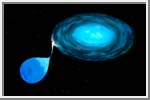|
COMETS EARTH JUPITER KUIPER BELT MARS MERCURY METEORITES NEPTUNE OORT CLOUD PLUTO SATURN SOLAR SYSTEM SPACE SUN URANUS VENUS ORDER PRINTS
PHOTO CATEGORIES SCIENCEVIEWS AMERICAN INDIAN AMPHIBIANS BIRDS BUGS FINE ART FOSSILS THE ISLANDS HISTORICAL PHOTOS MAMMALS OTHER PARKS PLANTS RELIGIOUS REPTILES SCIENCEVIEWS PRINTS
|
Related Document
Download Options
This is an illustration of a double star system at the heart of the globular cluster NGC 6624, located approximately 28,000 light-years away in the constellation Sagittarius. The star is a source of powerful bursts of X-ray emission. The Hubble Space Telescope recently detected the ultraviolet light from hot disk of gas within the binary system, thereby identifying its optical component. One member of the binary is a neutron star, an extremely dense and compact corpse of a massive star that exploded long ago. The neutron star is slowly devouring its larger but less-massive white- dwarf star companion, seen at lower left. Tidal forces from the neutron star's intense gravitation pull stretch the dwarf into an egg-shape. (A white dwarf is the remnant of a burned out Sun-like star.) Gas pulled from the dwarf flows across a narrow accretion bridge and then smear out into a swirling disk.The energy released by the continuous infall of gas onto the neutron star produces the steady X-ray emission. This gusher of radiation heats temperatures greater than 100,000 degrees Fahrenheit -- as estimated by the ultraviolet emission detected by Hubble. The infall also supplies fuel for sporadic, intense X-ray bursts. These occur when enough gas accumulates on the surface of the neutron star to ignite spontaneously, creating an enormous nuclear fusion bomb. For a few seconds, the outburst abruptly outshines the usual steady X-ray emission. The stars complete an orbit about each other every eleven minutes, making this the fastest binary system known. The stars are only 100,000 miles apart, or less than half the distance between Earth and the Moon. Image use statement at the time this image was obtained. All of the HST images available via WWW and ftp may be used without restriction as long as credit information accompanies the picture. Credit usually includes the principal scientist responsible for the data, AURA/STScI, NASA and/or ESA, the European Space Agency. Specific credit information may be found in the captions accompanying the images as plain text files. The captions are available via links from the Web pages as well as separate files in the gif directory on the ftp server. |
